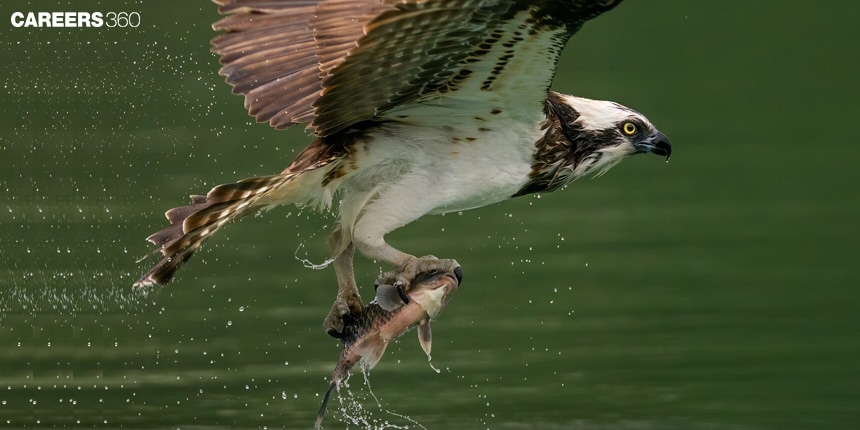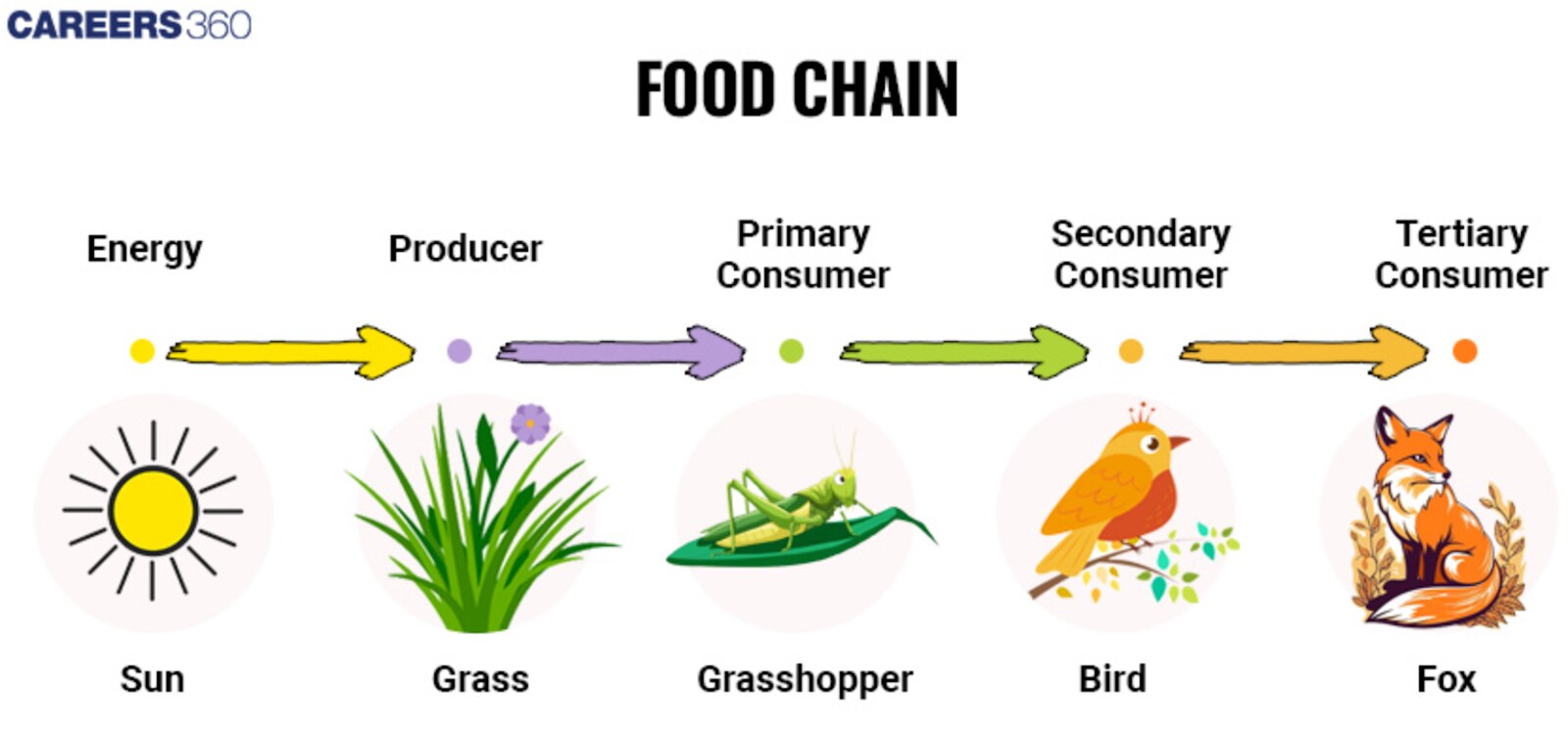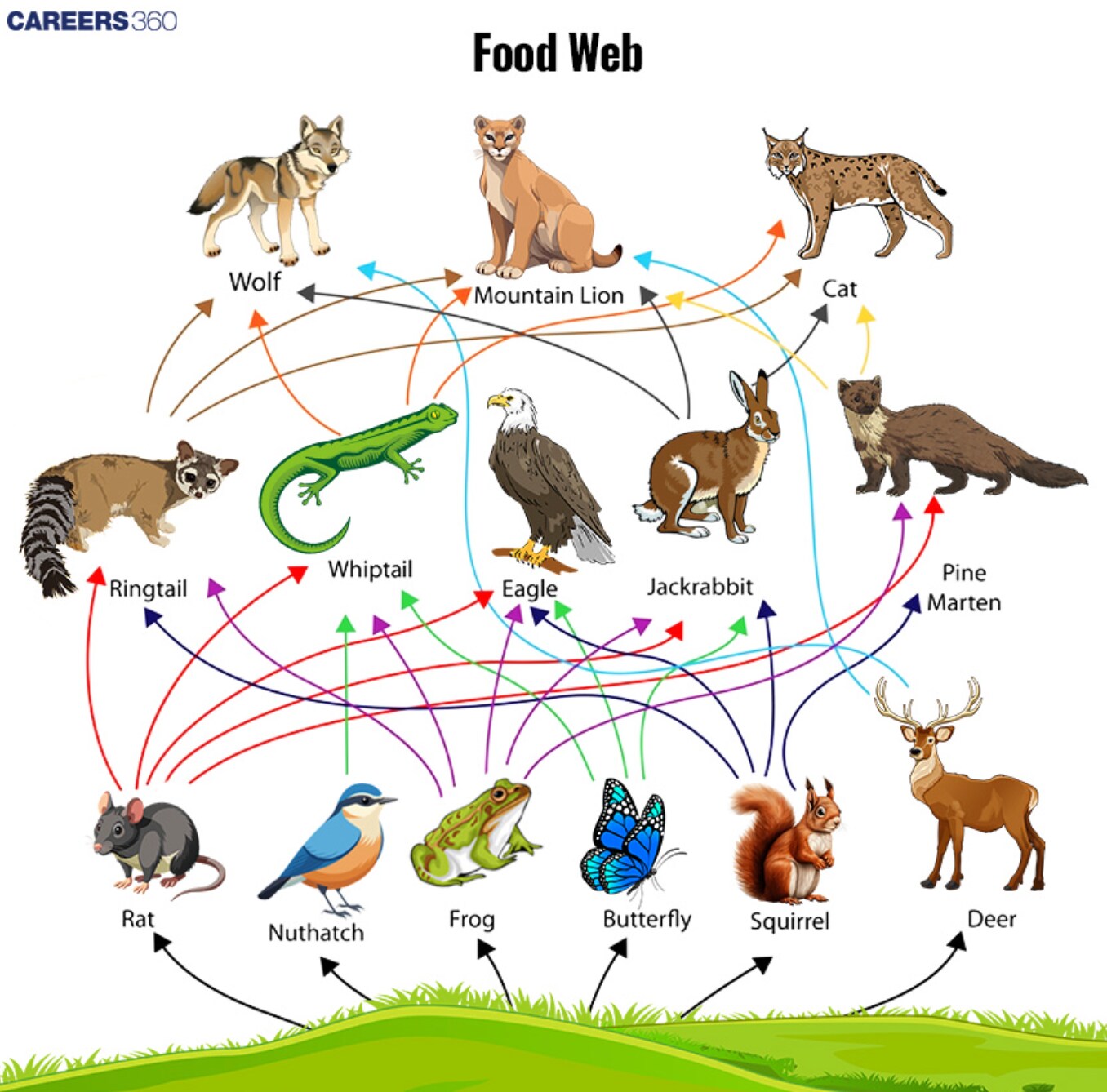Food Chain And Food Web
A food chain can be described as the series of feeding relationships where one organism is eaten by the other organism in the succeeding line this shows how energy and nutrients flow from one organism in the chain to the next. There is a difference between a food chain and a food web, the latter representing various interconnected food chains with an ecosystem designing the complex relations between diverse species. This is an important part of the Ecology unit in Biology.
NEET 2025: Mock Test Series | Syllabus | High Scoring Topics | PYQs
NEET Important PYQ's Subject wise: Physics | Chemistry | Biology
New: Meet Careers360 B.Tech/NEET Experts in your City | Book your Seat now

What is a Food Chain?
A food chain, on the other hand, is a straight way that depicts the energy and the nutrient flow in an ecosystem from the consumers to the producers and between the different consumers. It shows the consumption chain of different species of organisms right from the producer organisms to the higher-order consumer organisms.
Trophic Levels of Food Chain
The major components of trophic levels are:
Producers (Autotrophs)
Plants can manufacture their food by photosynthesis, whereas if they are not plants and perform chemosynthesis, they become the first or primary consumers. This includes green plants, algae and some bacteria, as they are the ones that contain the photosynthetic pigments.
Primary Consumers (Herbivores)
These organisms feed on producers and they are ranked under the second order of consumers. The secondary consumers on the pyramid of food chains. This has placed them as the first-order consumers in the food chain. These are cattle deer rabbits.
Secondary Consumers (Carnivores)
- These organisms are found in the subsequent trophic level and are used by the primary consumers of food. This could either be being a purely meat consumer or being both a meat and grain or cereal consumer.
Tertiary Consumers (Apex Predators)
These are the ultimate predators which only have a man as their competitor or frankly struggle for survival with other members of the same species. However, it is a mesopredator and has a feeding relationship with the secondary level of the food pyramid. This is very important in maintaining the balance of the ecosystem. This one is personal for lions, eagles, and sharks.
Read More:
Types of Simple Food Chains
Some examples of simple food chains are discussed below
Terrestrial Food Chain
Grass being a producer level is consumed by grasshoppers at a primary consumer level. Frogs feed on grasshoppers whereas snakes feed on frogs. Last in the food chain, hawks feed on snakes and hawks are the highest predation level of the food chain. This includes:
Grassland Ecosystem
Producer: Grass
Primary Consumer: Grasshopper
Secondary Consumer: Frog
Tertiary Consumer: Snake
Apex Predator: Hawk
Aquatic Food Chain
The primary consumer is phytoplankton (producer) and on this trophic level, the zooplankton or primary consumer feeds on phytoplankton. Small fish feed on zooplanktons while the big fish feed on the small fish. Pike is the apex predator that feeds on much larger fish.
Lake Ecosystem
Producer: Phytoplankton
Primary Consumer: Zooplankton
Secondary Consumer: Small Fish
Tertiary Consumer: Larger Fish
Apex Predator: Pike
Linear Food Chain

What is a Food Web?
A food chain is a simple sequence of feeding tropism within an ecosystem while a food web refers to a group feeding relationship in an ecosystem. While a food chain describes a flow of organisms along which every successive member is the food of the next, a food web depicts more than one food chain. It consists of various organisms and the way they feed, showing the way energy passes through and nutrients are recycled in an ecosystem.
Difference Between Food Chain And Food Web
Some of the major points is discussed below:
Food Chain
Defines one line of a series of organisms.
Prescribes a direct transfer mechanism of energy and nutrients from one organism to the other.
Cuts the feeding relationships in an ecosystem by half.
Food Web
Stands for a collection of food chains that are interrelated in some or all their aspects.
Collects data on different species of animals and different relations among them.
Helps in understanding how feeding relationships and trophic interactions are winding and not always directly in an ecosystem.
Complexity of Food Webs
Food webs are characterised by their complexity due to Food webs are characterised by their complexity due to:
Interconnected: Several species are involved in predation and/or parasitism, which shows the dependency of one organism on another.
Energy Flow Dynamics: Energy and nutrients circulate in several routes that touch different levels of tropism.
Species Diversity: Murder allows a large grouping of organisms of different trophic levels including the producers and top predators.
Types of Food Webs
Some examples of food webs are:
Forest Ecosystem Food Web
In a forest ecosystem, the food web can be represented as follows: In a forest ecosystem, the food web can be represented as follows:
Producers (Primary producers): Trees, shrubs, grasses
Primary Consumers (Herbivores): Deer, rabbits, moth larvae, and other insects.
Secondary Consumers (Carnivores/Omnivores): Depending on the territory foxes, owls, snakes and spiders.
Tertiary Consumers (Top Predators): A wolf and a mountain lion
Interconnections:
Herbivores: They have specific diets that include feeding on leaves as well as grasses.
Carnivores: Foxes feed on rabbits while on the other hand owls feed on small mammals and insects.
Top Predators: Well, wolves eat deer, thus keeping the diseases in check from the herbivores.
Types of interactions:
- Most of the time the caterpillars are seen feeding on the trees foliage while the birds feed on the caterpillars.
- The foxes and owls do compete for a source they both feed on small mammals.
Marine Ecosystem Food Web
In a marine ecosystem, the food web is more diverse and complex due to the abundance of species and varied habitats. In a marine ecosystem, the food web is more diverse and complex due to the abundance of species and varied habitats.
Producers (Primary producers): They include Phytoplanktons, seaweed and seagrass.
Primary Consumers (Herbivores): Zooplankton, fish fry especially anchovy, shrimp, small and moderate-sized fish, and jellyfish.
Secondary Consumers (Carnivores/Omnivores): Squid, other big fish (e.g.. tuna, sharks)
Tertiary Consumers (Top Predators): Dolphins, seals, large predatory fish (e.g., marlin)
Interconnections:
- Herbivores: The zooplankton feed at the bottom of the seas on phytoplanktivities, whereas small fishes feed on seaweed and seagrasses.
- Carnivores: Zooplanktons are the food item of squids and Tuna and other large fish are found to feed on small fish and squids.
- Top Predators: Some of the Primates’ diets include fruits and vegetables, while reptiles feed on insects and small animals, while birds feed on insects and fish and so on thus giving out a balanced diet.
Types of interactions:
- Dolphins or seals may feed on the same sort of prey, probably the small fish species in the sea.
- Sharks are other cool examples that function as predators which in turn help in controlling the numbers of other sea creatures.
Complex Food Web

Also Read
The Video Recommended On Food Chain And Food Web
Frequently Asked Questions (FAQs)
A food chain can be defined as a flow chart that only illustrates one flow of energy and nutrients in the ecosystem in the form of consumer producers and decomposers.
The food web is a more refined concept than the food chain and it shows various chains in one ecosystem, the relations of feeding connections.
Energy moves unequally and cyclically in that producers which are plants and algae transform solar energy into chemical energy in the form of food.
The energy that is stored in the producers is then transferred through the successive trophic levels in the consumers’ food chain and it can be established by pale ecologists that usually about 10% of the energy escalates to the next trophic level.
Finally, metabolic work is done and energy is dissipated as heat and lost in the process.
Decomposers feed on dead organisms (organisms that have died), fallen trees leaves and other dead things in the ecosystem and convert it to simpler forms of matter which can be easily reused in the ecosystem.
They rank just as important as decomposers in the decomposition of organic matter hence releasing nutrients such as nitrogen and phosphorus back into the soil for use by plants and producers.
Some of the human activities that affect food chains and food webs are deforestation, pollution of water sources, fishing that affects the various food types and habitat destruction.
Such factors include the effect of changing the balance of predation and competition through the introduction of invasive species.
Climate change alters the position of species in a geographical space and also influences the frequencies of biological events such as migration and reproduction.
Apex predators maintain the numbers of other animals within the environment so that herbivores, for instance, do not overproduce and feed on all the plants.
They assist in regulating the numbers of the prey species and hence play a critical role in shaping the coherent food web.
It means the presence of their population is a sign of the overall ecosystem, predator-prey balance and fully functional trophic level.
Also Read
29 Nov'24 01:08 PM
25 Nov'24 08:54 AM
21 Nov'24 03:53 PM
21 Nov'24 01:52 PM
15 Nov'24 02:15 PM
14 Nov'24 09:05 AM
14 Nov'24 08:45 AM
13 Nov'24 10:19 PM